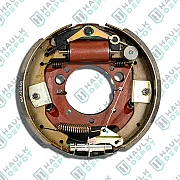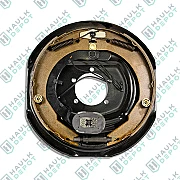Brakes












Trailer Braking Solutions: A Complete Guide to Brakes
Regardless of appearance, the importance of brakes in maintaining safe driving cannot be overstated. To stop efficiently, your car must have three simple yet essential components. When pulling a trailer, safety comes first. The braking system is essential for safe towing.
To drive safely and enjoyably, you must first understand the various components of a trailer brake system. We'll look at the various trailer brake systems and the components that keep them working properly.
A Comprehensive Overview of Trailer Brake Systems
Trailer braking systems increase safety by allowing the trailer to brake independently from the towing vehicle. This function reduces the chance of skidding and jackknifing during sudden stops or turns. They aid in reducing stopping distances, which enhances control in critical situations. They increase stability, making towing safer, particularly on uneven roads or in emergencies.
Electric Brake System
When the driver applies pressure to the brake pedal, the brake controller in the towing vehicle engages the trailer's brakes. A braking drum, brake shoes, and a magnet are included with every brake. The braking force is produced when the brake shoes are drawn toward the drum by the magnet. Drum systems work best with electric brakes, which require changes according to the trailer's weight, the state of the road, and the weather.
Electric Over Hydraulic (EOH) Brake System
EOH systems give heavier trailers more stopping force by combining hydraulic braking power with electronic controls. A hydraulic pump placed on a trailer receives a signal from the brake controller and uses brake lines to deliver pressure to the wheels. These systems are adaptable to a range of trailer types because they may be used with both disc and drum brakes. During trailer detachment, the hydraulic pump is powered by a backup battery, which keeps the brakes working.
Hydraulic Brake System
With hydraulic brakes, force is transferred to one or more wheel brakes via a transmission unit via a master cylinder. For further actuation, these systems, which are frequently seen in drum or disc brake layouts, may incorporate mechanical parts like cables or pull rods. Overrun brakes, which increase stability and offer smoother braking, are a feature of certain hydraulic systems.
Recognizing Brake Failure Symptoms
For dependable and secure trailer operation on the road, routine maintenance and appropriate braking system component adjustment are necessary. Like any other mechanical system, trailer brakes can have problems. The following are some typical issues and possible fixes for them:
1. Inadequate Braking Power
One typical problem that lengthens stopping distances and raises the danger of accidents is inadequate braking power.
-
Causes: Pneumatic and hydraulic systems frequently malfunction in cold climates, which lowers their effectiveness.
-
Solution: Electric brakes ensure safer and more dependable braking by providing consistent performance, especially on snowy roads.
2. Wheel Lockup on Slippery Surfaces
On icy or slick roads, wheel lockup poses a major safety risk.
-
Effects: Lockup raises the danger of accidents by causing trailer sway or jackknifing.
-
Solution: Lockup is avoided and overall stability is increased via systems that track wheel speed and lower braking force.
3. Electrical System Challenges
System faults might cause electrical brakes to work poorly.
-
Causes: Improper brake engagement may be caused by wiring issues or battery exhaustion.
-
Solution: These issues are resolved by dependable controllers coupled to the wiring of the towing vehicle and trailer-mounted batteries.
4. Lack of Brake Temperature Monitoring
Although frequently disregarded, brake temperature monitoring is essential for safety.
-
Issues: Performance is compromised by overheated brakes, which lose their effectiveness.
-
Solution: To identify overheating and increase safety, estimate brake temperature using signal data and actuation duration.
Diagnosing Common Brake Issues
A completely operational braking system is essential for any car to prevent issues while you're driving. Brakes are essential for safe driving because they are your car's primary defense system. They guarantee seamless navigation and regulate the vehicle's speed.
Above all, they force your car to stop at critical times.
Several factors can influence the performance and longevity of brake pads:
-
Wear can be accelerated by aggressive driving, such as repeated hard braking.
-
Vehicles that weigh more need to be stopped with greater force, which accelerates wear.
-
Because of frequent braking, driving in hilly terrain or stop-and-go traffic can increase wear.
-
Performance is greatly impacted by the production and friction material quality.
Replacing Key Brake Components
The safety of you, your passengers, and other cars on the road depends on knowing when to replace your brake pads. The following warning indicators point to the need for brake pad replacement:
-
When you press the brakes and hear a high-pitched squealing sound, it's a definite sign that your brake pads need to be replaced because they've worn down considerably.
-
When braking, you may feel vibrations or pulsations through the brake pedal, which could be a sign of warped rotors or uneven brake pad wear.
-
Examine your brake pads visually on a regular basis. It is time to install new pads if the thickness of the pads is less than a quarter of an inch.
By being aware of these warning signs of worn brake pads, you can take preventative measures to keep your car safe while driving and make sure you can stop when necessary.
Maintenance Intervals and Service Best Practices
You may save money on early brake pad replacement, guarantee maximum braking performance, and prolong the life of your brake pads with proper maintenance. Here are some crucial pointers for maintaining brake pads:
-
Have a qualified mechanic check your brake pads for wear and tear on a regular basis. They will search for any indications of damage, thinning, or uneven wear.
-
Maintaining the cleanliness of your brake pads can help guarantee that they are properly touching the brake rotor. Just gently clean the pads with a soft brush or cloth to get rid of any accumulated dirt, debris, or brake dust.
-
Avoid using hard, sudden brakes wherever possible. Because they are not subjected to as much strain, the brake pads last longer when braking smoothly and gradually.
Keep in mind that by keeping your car's braking system in good working order, you'll be able to prolong the life of your brake pads and keep the safety and comfort you require while driving.
Shop Quality Braking Systems
The safety and efficiency of your car's braking system are greatly influenced by the brake pads. You'll be able to confidently maintain your brake pads and choose when to have them replaced using the knowledge we've discussed above.
Look no further than Haulk Depot if you're looking for trustworthy shops for dependable brake replacement parts. We can assist in making sure your braking system and brake pads are in excellent shape so you can always rely on your car to stop when you need it.




























